Code completion
This section covers various techniques of context-aware code completion that allow you to speed up your coding process.
Basic completion
Basic code completion helps you complete the names of classes, methods, and keywords within the visibility scope. When you invoke code completion, PhpStorm analyses the context and suggests the choices that are reachable from the current caret position (suggestions also include Live templates).
If basic code completion is applied to a part of a field, parameter, or variable declaration, PhpStorm suggests a list of possible names depending on the item type.
Invoking basic code completion for the second time shows inaccessible classes and members (these can be made public by applying an intention action).
Invoke basic completion
Start typing a name. By default, PhpStorm displays the code completion popup automatically as you type.
If automatic completion is disabled, press Ctrl+Space or choose from the main menu.
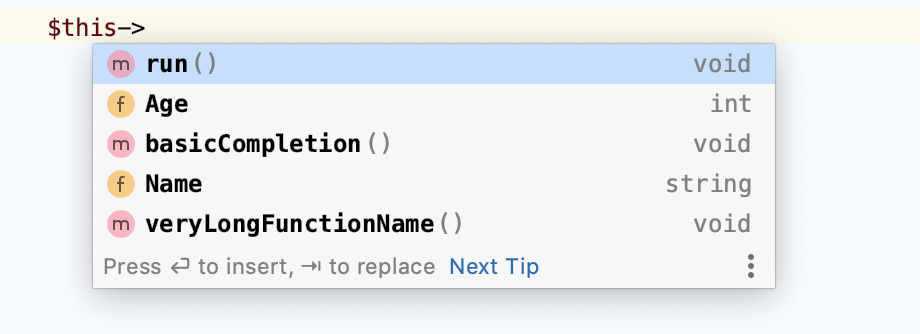
If necessary, press Ctrl+Space for the second time (or press Ctrl+Alt+Space).
This shows inaccessible classes and members as well as static fields and methods.
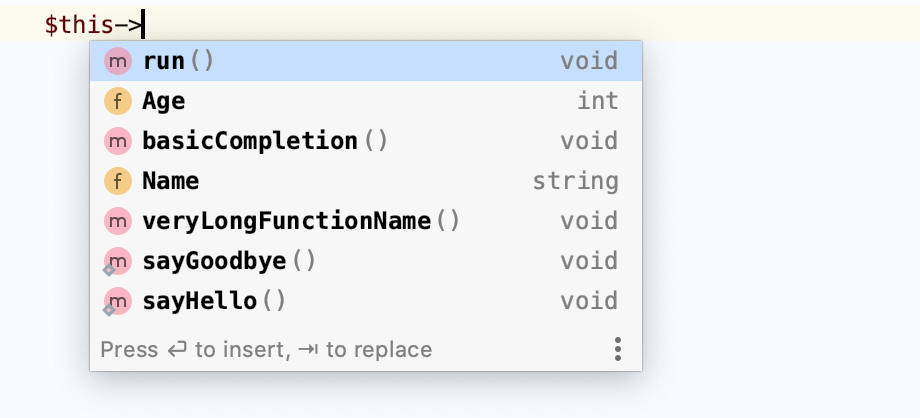
Type-matching completion
Smart type-matching code completion filters the suggestions list and shows only the types applicable to the current context.
Invoke type-matching completion
Start typing. By default, PhpStorm displays the code completion popup automatically as you type. If automatic completion is disabled, press Ctrl+Shift+Space or choose from the main menu.
- Press Ctrl+Shift+Space or choose from the main menu.
The most suitable suggestion for the current context is highlighted.

Statement completion
You can create syntactically correct code constructs by using statement completion. It inserts the necessary syntax elements (parentheses, braces, and semicolons) and gets you in a position where you can start typing the next statement.
Complete a method declaration
Start typing a method declaration and press Ctrl+Shift+Enter after the opening parenthesis.
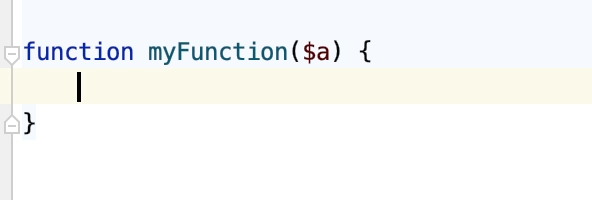
Complete a code construct
Start typing a code construct and press Ctrl+Shift+Enter.
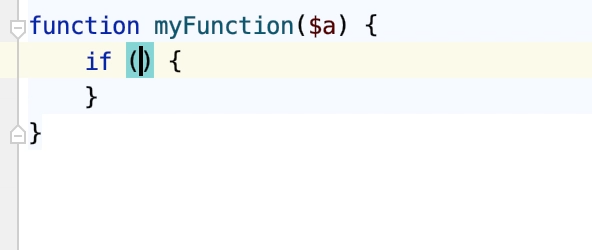
PhpStorm automatically completes the construct and adds the required punctuation. The caret is placed at the next editing position.
Wrap a method call argument
Type an expression. Then type a method call. When
strlengets the focus in the suggestion list, select it with Ctrl+Shift+Enter: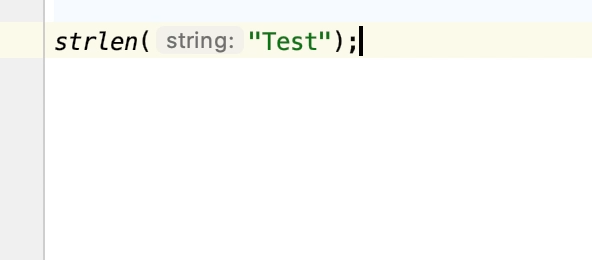
Hippie completion
Hippie completion is a completion engine that analyses your text in the visible scope and generates suggestions from the current context. It helps you complete any word from any of the currently opened files.
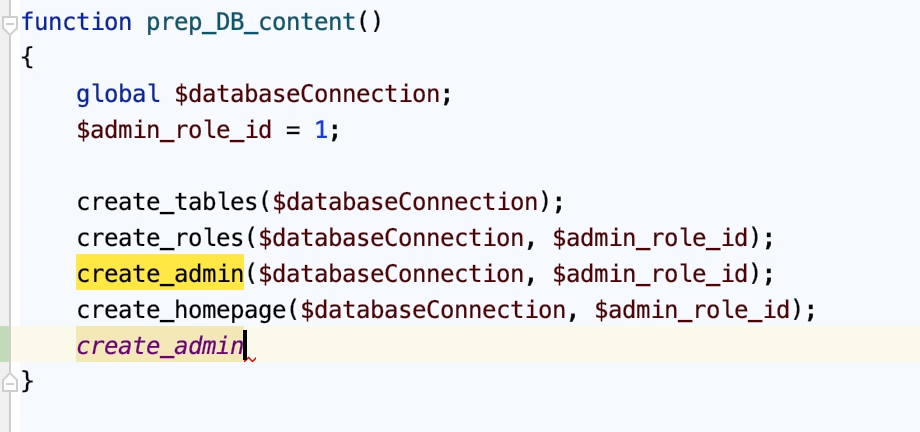
Expand a string at caret to an existing word
Type the initial string and do one of the following:
Press Alt+/ or choose to search for matching words before the caret.
Press Alt+Shift+/ or choose to search for matching words after the caret and in other open files.
The first suggested value appears, and the prototype is highlighted in the source code.

Accept the suggestion, or hold the Alt key and keep pressing / until the desired word is found.
Postfix code completion
Postfix code completion helps you reduce backward caret jumps as you write code. You can transform an already-typed expression to a different one based on a postfix you type after the dot, the type of expression, and its context.
Enable and configure postfix completion
Go to Settings / Preferences | Editor | General | Postfix Completion and select the Enable postfix completion checkbox.
Select Tab, Space, or Enter to be used for expanding postfix templates.
Enable/disable a particular postfix template for the selected language.
Transform a statement with a postfix
Type an expression and then type a postfix after a dot, for example,
.if:function m(arg) { arg.if }The initial expression gets wrapped with an
ifstatement:function m(arg) { if (arg) { } }
You can disable certain postfix completion templates in the Editor | General | Postfix Completion page of the IDE settings Ctrl+Alt+S.
You can select Tab, Space, or Enter to expand postfix templates.
You can edit the predefined postfix templates, for example, to replace a long key with a shorter one, or to expand the list of applicable expression types.
Create custom postfix templates
Press Ctrl+Alt+S to open IDE settings and select Editor | General | Postfix Completion.
Click the Add button (
) on the toolbar. In the popup menu that opens, choose the language that you need to create a postfix template for.
Specify the Key that is the combination of symbols that will invoke the template. Select which expression types the new template will be applicable to, and type the target expression in the following format:
$EXPR$ <target_expression>, for example,$EXPR$ !== null.Add
$END$where you want the caret to be placed after the template is applied, for example:$EXPR$ !== null; $END$To have PhpStorm automatically transform the topmost applicable expression when the template is invoked, select the Apply to the topmost expression checkbox.
Otherwise, if the checkbox is cleared, PhpStorm will prompt you to choose the expression when you invoke the template:
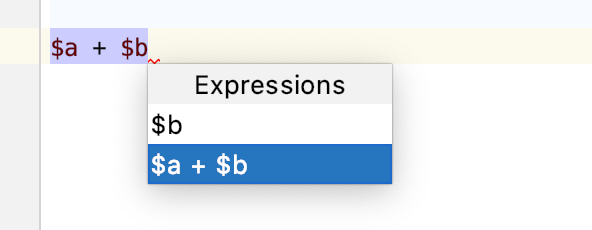
Completion of tags and attributes
PhpStorm automatically completes names and values of tags and attributes in many file types:
HTML/XHTML, including completion for CSS classes and for HTML tags inside JSX.
XML/XSL, including completion for namespaces.
JSON, see Editing package.json for details.
Completion of tags and attribute names is based on the DTD or Schema the file is associated with. If there is no schema association, PhpStorm will use the file content (tag and attribute names and their values) to complete your input.
Complete tag names
Press < and start typing the tag name. PhpStorm displays the list of tag names appropriate in the current context.

Use the Up and Down buttons to scroll through the list.
Press Enter to accept a selection from the list. If your file is associated with a schema or a DTD, PhpStorm automatically inserts the mandatory attributes according to it.
Configure code completion settings
Configure completion options
Press Ctrl+Alt+S to open IDE settings and select Editor | General | Code Completion.
To automatically display the suggestions list, select the Show suggestions as you type checkbox. If the checkbox is cleared, you have to call code completion explicitly by pressing Ctrl+Space for basic completion or Ctrl+Shift+Space for type-matching completion.
You can also choose to automatically insert suggestions when there's just one option: select the completion type under Automatically insert single suggestions for.
To sort suggestions in the alphabetical order, instead of sorting them by relevance, select the Sort suggestions alphabetically checkbox.
You can also toggle these modes by clicking
or
respectively in the lower-right corner of the suggestions list.
If you want the word case to be taken into account when suggesting completion options, select Match case and choose whether you want to match case for first letters only, or for all letters.
If you want the documentation popup to be displayed automatically for each item in the suggestions list as you scroll it, select the Show documentation popup in option. In the field to the right, specify the delay (in milliseconds), after which the popup should appear.
Completing a path
This type of completion speeds up selection of files and folders. The dialog used for that purpose is called rather often, for example, when you specify the installation folder of an external tool or a Version Control engine or configure a PHP interpreter.
Open the Select Path dialog by choosing on the menu or by clicking Browse
next to the field where a path is required.
Make sure that the Path field is visible. If the field is hidden, click the Show path link.
Start typing a path. PhpStorm suggests a list where you can quickly find the needed directory.
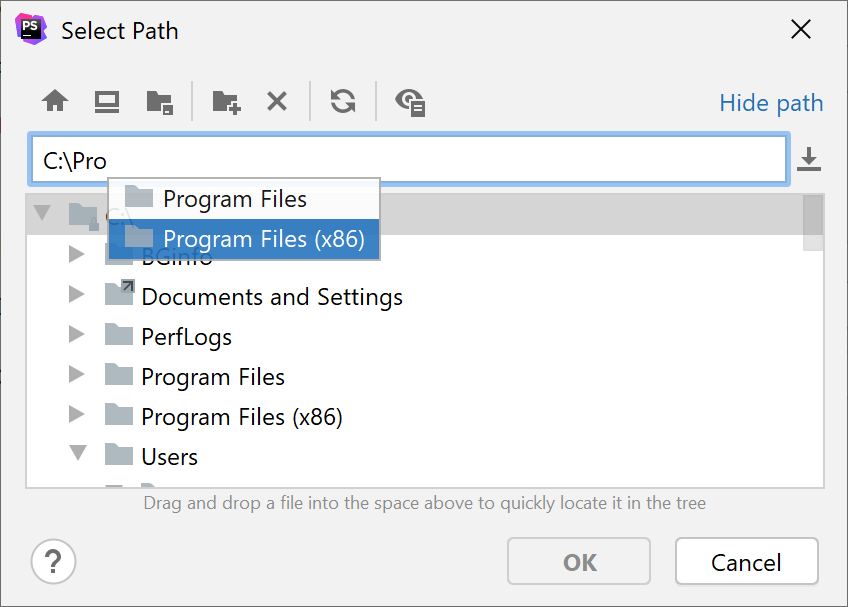
As you type, the suggestion list shrinks to show the matching paths only.
You can also press Ctrl+Space to show the suggestion list.
Select the relevant suggestion from the list.
Completion tips and tricks
Narrow down the suggestions list
You can narrow down the suggestions list by typing any part of a word (even characters from somewhere in the middle) or invoking code completion after a dot separator or
->. PhpStorm will show suggestions that include the characters you've entered in any positions.This makes the use of wildcards unnecessary:
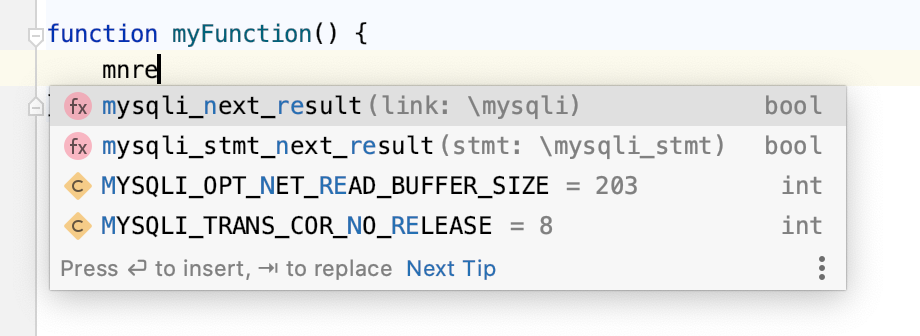
In case of CamelCase or snake_case names, type the initial letters only. PhpStorm automatically recognizes and matches the initial letters.
Accept a suggestion
You can accept a suggestion from the list in one of the following ways:
Press Enter or double-click a list item to insert it to the left of the caret.
Press Tab to replace the characters to the right from the caret.
Use Ctrl+Shift+Enter to make the current code construct syntactically correct (balance parentheses, add missing braces and semicolons, and so on).
You can also use specific keys to insert the selected completion suggestion: go to the Editor | General | Code Completion page of the IDE settings Ctrl+Alt+S and select the Insert selected suggestion by pressing space, dot, or other context-dependent keys option. These keys depend on the language, your context, and so on.
View reference
You can use the Definitions by pressing Ctrl+Shift+I when you select an entry in the suggestions list:
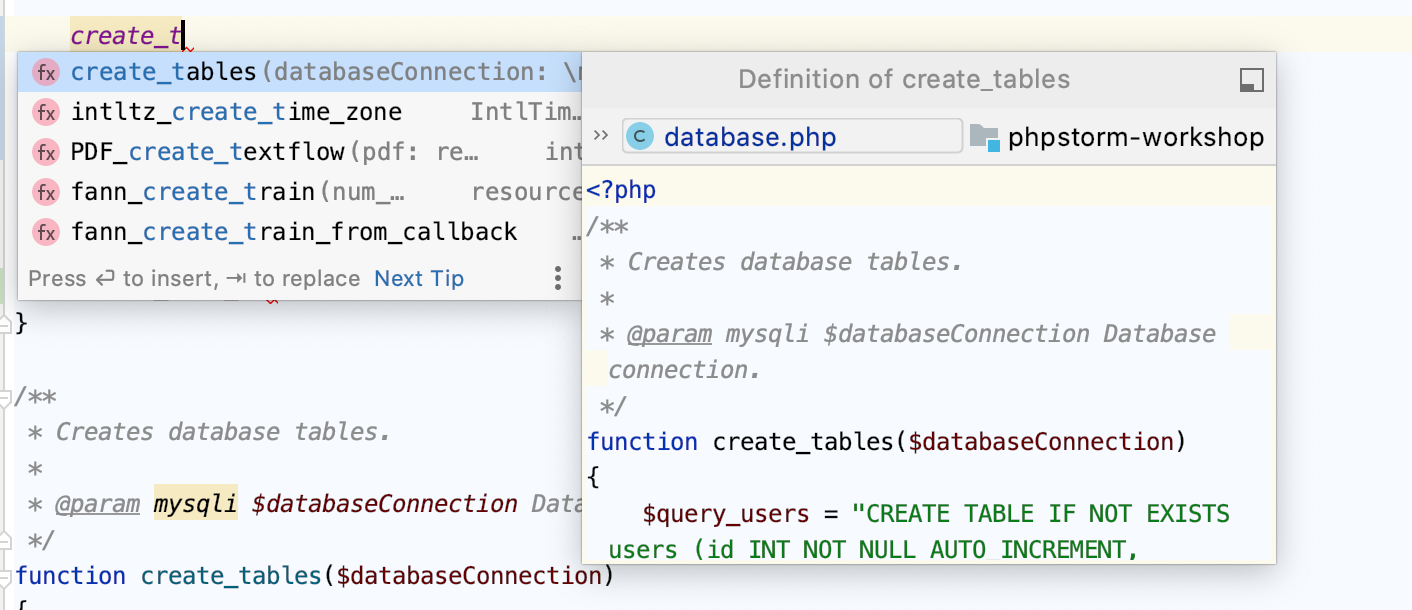
You can use the Quick Information view by pressing Ctrl+Q when you select an entry in the suggestions list:

View code hierarchy
You can view code hierarchy when you've selected an entry from the suggestions list:
Ctrl+H- view type hierarchy
Ctrl+Alt+H- view call hierarchy.
Ctrl+Shift+H- view method hierarchy.
Use machine-learning-assisted code completion
For PHP, JavaScript, and TypeScript, you can utilize machine learning models to rank most suitable items higher in the suggestions list.
The suggestions list will change to look like the following with the arrows showing you how it was re-ordered based on ML, and the most suitable suggestion on the top marked with the star: 
To do this, go to
Press Ctrl+Alt+S to open IDE settings and select Editor | General | Code Completion.
Troubleshooting
If code completion doesn't work, this may be due to one of the following reasons:
The Power Save Mode is on (File | Power Save Mode). Turning it on minimizes power consumption of your laptop by eliminating the background operations, including error highlighting, on-the-fly inspections, and code completion.
Your file doesn't reside in a content root, so it doesn't get the required class definitions and resources needed for code completion.
A file containing classes and functions that you want to appear in completion suggestions list is marked as a plain text file.
External libraries that contain functions that you want to appear in the completion suggestions list are not added as dependencies or global libraries.